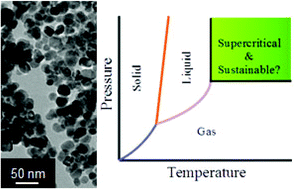Anticipatory life-cycle assessment of supercritical fluid synthesis of barium strontium titanate nanoparticles†
Abstract
Supercritical fluid synthesis offers an attractive and unique method to produce metal oxide nanoparticles such as barium strontium titanate (Ba1−xSrxTiO3 with 0 ≤ x ≤ 1). This synthesis pathway has the advantage of producing high quality, highly crystalline nanoparticles in a narrow size range, with accurate control of the elemental composition not easily afforded by other methods of production. Coupled with moderate reaction temperatures and short reaction times, this method could be an environmentally preferred synthesis route compared to conventional synthesis pathways. This paper examines the potential environmental impacts leading from the lab-scale supercritical synthesis of 1 kg of Ba0.6Sr0.4TiO3 nanoparticles of an average size 16 nm using the approach of an anticipatory life-cycle assessment. A cradle-to-gate assessment was completed, estimating the impacts across resource extraction, material processing, and production of the nanoparticles, while excluding any associated use-phase or end-of-life considerations. The life-cycle assessment highlights a number of ways by which the environmental profile of the supercritical synthesis of barium strontium titanate nanoparticles could be improved. Lab-scale synthesis was bound by physical constraints of the reactor, whereby the precursor concentration was kept artificially low. Being able to synthesize nanoparticles with precursor concentrations of 0.1 and 1.0 molar would reduce the average life-cycle impacts by nearly 81% and 95%, respectively. Additionally, the recovery and reuse of solvents at high recycling rates (e.g. 90%) could reduce average life-cycle impacts by 56%. At high precursor concentrations and solvent recycling rates, the environmental performance was further limited by the precursors, namely barium and titanium alkoxides, which have high upstream life-cycle demands (i.e. isopropanol production and metal processing). General impact reductions were seen as the ratio of strontium : barium increased. Further reductions could be achieved by replacing the barium, strontium and titanium alkoxides with precursors having better life-cycle profiles such as barium and strontium acetates or barium and strontium hydroxides.


 Please wait while we load your content...
Please wait while we load your content...